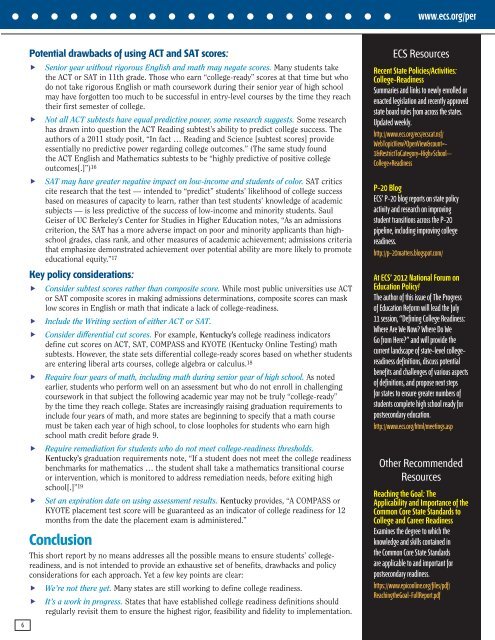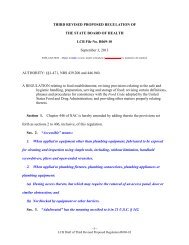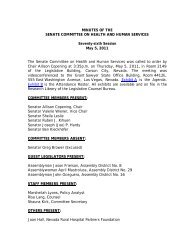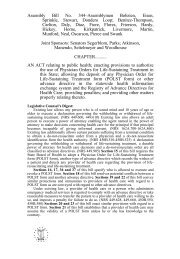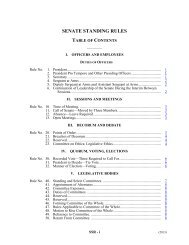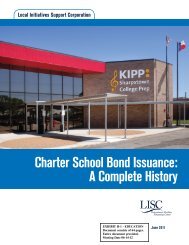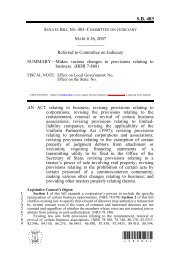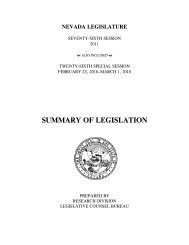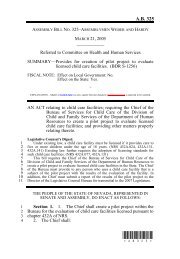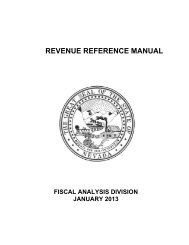Exhibit M-1
Exhibit M-1
Exhibit M-1
Create successful ePaper yourself
Turn your PDF publications into a flip-book with our unique Google optimized e-Paper software.
6<br />
Potential drawbacks of using ACT and SAT scores:<br />
Senior year without rigorous English and math may negate scores. Many students take<br />
the ACT or SAT in 11th grade. Those who earn “college-ready” scores at that time but who<br />
do not take rigorous English or math coursework during their senior year of high school<br />
may have forgotten too much to be successful in entry-level courses by the time they reach<br />
their first semester of college.<br />
Not all ACT subtests have equal predictive power, some research suggests. Some research<br />
has drawn into question the ACT Reading subtest’s ability to predict college success. The<br />
authors of a 2011 study posit, “In fact … Reading and Science [subtest scores] provide<br />
essentially no predictive power regarding college outcomes.” (The same study found<br />
the ACT English and Mathematics subtests to be “highly predictive of positive college<br />
outcomes[.]”) 16<br />
SAT may have greater negative impact on low-income and students of color. SAT critics<br />
cite research that the test — intended to “predict” students’ likelihood of college success<br />
based on measures of capacity to learn, rather than test students’ knowledge of academic<br />
subjects — is less predictive of the success of low-income and minority students. Saul<br />
Geiser of UC Berkeley’s Center for Studies in Higher Education notes, “As an admissions<br />
criterion, the SAT has a more adverse impact on poor and minority applicants than highschool<br />
grades, class rank, and other measures of academic achievement; admissions criteria<br />
that emphasize demonstrated achievement over potential ability are more likely to promote<br />
educational equity.” 17<br />
Key policy considerations:<br />
Consider subtest scores rather than composite score. While most public universities use ACT<br />
or SAT composite scores in making admissions determinations, composite scores can mask<br />
low scores in English or math that indicate a lack of college-readiness.<br />
Include the Writing section of either ACT or SAT.<br />
Consider differential cut scores. For example, Kentucky’s college readiness indicators<br />
define cut scores on ACT, SAT, COMPASS and KYOTE (Kentucky Online Testing) math<br />
subtests. However, the state sets differential college-ready scores based on whether students<br />
are entering liberal arts courses, college algebra or calculus. 18<br />
Require four years of math, including math during senior year of high school. As noted<br />
earlier, students who perform well on an assessment but who do not enroll in challenging<br />
coursework in that subject the following academic year may not be truly “college-ready”<br />
by the time they reach college. States are increasingly raising graduation requirements to<br />
include four years of math, and more states are beginning to specify that a math course<br />
must be taken each year of high school, to close loopholes for students who earn high<br />
school math credit before grade 9.<br />
Require remediation for students who do not meet college-readiness thresholds.<br />
Kentucky’s graduation requirements note, “If a student does not meet the college readiness<br />
benchmarks for mathematics … the student shall take a mathematics transitional course<br />
or intervention, which is monitored to address remediation needs, before exiting high<br />
school[.]” 19<br />
Set an expiration date on using assessment results. Kentucky provides, “A COMPASS or<br />
KYOTE placement test score will be guaranteed as an indicator of college readiness for 12<br />
months from the date the placement exam is administered.”<br />
Conclusion<br />
This short report by no means addresses all the possible means to ensure students’ collegereadiness,<br />
and is not intended to provide an exhaustive set of benefits, drawbacks and policy<br />
considerations for each approach. Yet a few key points are clear:<br />
We’re not there yet. Many states are still working to define college readiness.<br />
It’s a work in progress. States that have established college readiness definitions should<br />
regularly revisit them to ensure the highest rigor, feasibility and fidelity to implementation.<br />
www.ecs.org/per<br />
ECS Resources<br />
Recent State Policies/Activities:<br />
College-Readiness<br />
Summaries and links to newly enrolled or<br />
enacted legislation and recently approved<br />
state board rules from across the states.<br />
Updated weekly.<br />
http://www.ecs.org/ecs/ecscat.nsf/<br />
WebTopicView?OpenView&count=-<br />
1&RestrictToCategory=High+School--<br />
College+Readiness<br />
P-20 Blog<br />
ECS’ P-20 blog reports on state policy<br />
activity and research on improving<br />
student transitions across the P-20<br />
pipeline, including improving college<br />
readiness.<br />
http://p-20matters.blogspot.com/<br />
At ECS’ 2012 National Forum on<br />
Education Policy!<br />
The author of this issue of The Progress<br />
of Education Reform will lead the July<br />
11 session, “Defining College Readiness:<br />
Where Are We Now? Where Do We<br />
Go from Here?” and will provide the<br />
current landscape of state-level collegereadiness<br />
definitions, discuss potential<br />
benefits and challenges of various aspects<br />
of definitions, and propose next steps<br />
for states to ensure greater numbers of<br />
students complete high school ready for<br />
postsecondary education.<br />
http://www.ecs.org/html/meetings.asp<br />
Other Recommended<br />
Resources<br />
Reaching the Goal: The<br />
Applicability and Importance of the<br />
Common Core State Standards to<br />
College and Career Readiness<br />
Examines the degree to which the<br />
knowledge and skills contained in<br />
the Common Core State Standards<br />
are applicable to and important for<br />
postsecondary readiness.<br />
https://www.epiconline.org/files/pdf/<br />
ReachingtheGoal-FullReport.pdf


